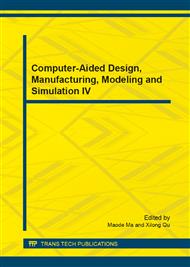p.531
p.536
p.541
p.545
p.550
p.555
p.559
p.568
p.575
Design and Development of Trade Detector Based on Distributed Computing Technology
Abstract:
J2EE is set for the distributed computing realization of API, services and protocols developed by SUN. The design objective of J2EE computer development tool is to provide a simple, easy operation development platform for developers, which can reduce the cost of development, shorten the development cycle, and improve the comprehensive performance of computer system. In this paper, we use JSP calculation vessel function module of J2EE to improve the computer economic detection system, and establish data connection between system and the HTML Webpage, which realizes the real-time and continuous detection of the economy. Finally, based on the external demand and exports of industrial products in an area, we detect trade transactions in the region, and do mathematical statistics using the J2EE system, and finally get the trade scale. It provides a new computer method for the research of export trade and economic detection.
Info:
Periodical:
Pages:
550-554
Citation:
Online since:
October 2014
Price:
Сopyright:
© 2014 Trans Tech Publications Ltd. All Rights Reserved
Share:
Citation:


